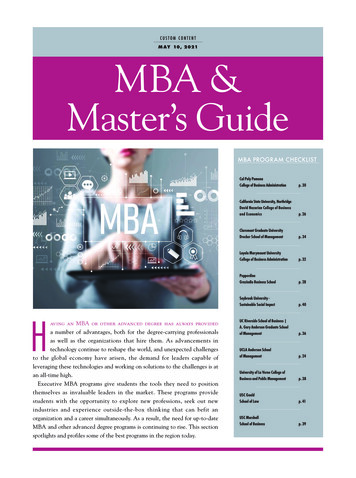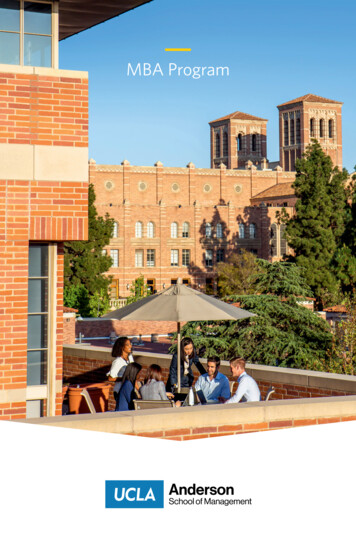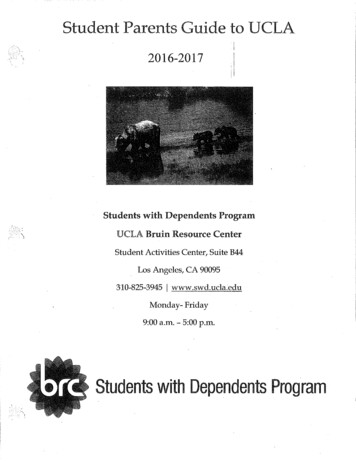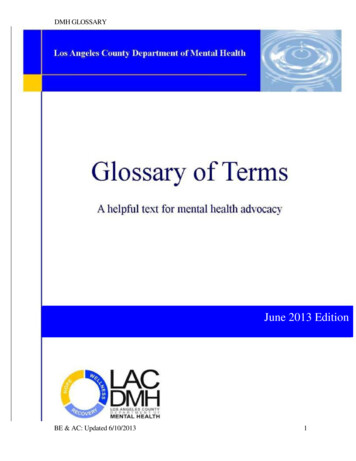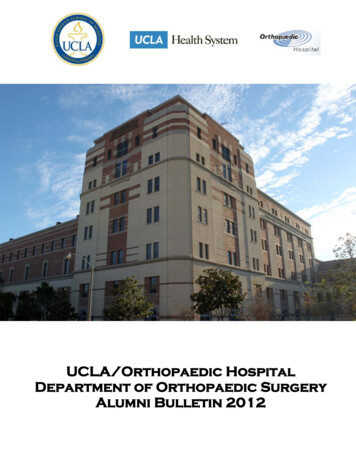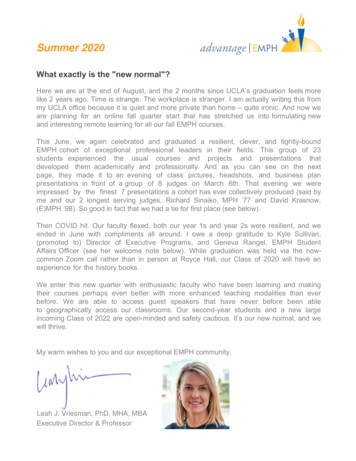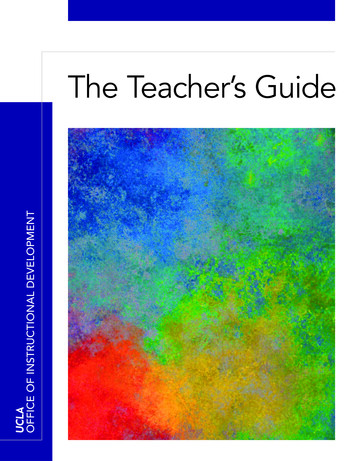
Transcription
OFFICE OF INSTRUCTIONAL DEVELOPMENTThe Teacher’s Guide
The Teacher’s Guide5th EditionUCLA Office of Instructional Development60 Powell Library BuildingLos Angeles, CA 90095-1515www.oid.ucla.edu 2008 by the Regents of the University of CaliforniaLatest Revision: June 2011
ii
The Teacher’s GuideSection A: Polices and Procedures1The University Context1The Campus Ombuds Office22California Public Higher Education1Avoiding Complaints23The University of California1Section B: Teaching Practice25University of California and Diversity1Course and Curriculum Planning25The UCLA Administrative Context2Designing an Undergraduate Course25The UCLA Student3Preparing Your Course25Enrolling and Advising Students5Standard Enrollment Procedures5Selecting and Ordering Course Yextbooksand Related Materials30Other Enrollment Procedures5Web-based Resources for Instruction32Special Programs Enrollment7Once Class Begins32Office Hours7Teaching Students with Disabilities34FERPA Guidelines for Faculty7Curricular Alternatives and Innovations35Counseling and Advising Students8Programs for Instructional Innovation35Suggested Readings38Student Writing39Your Student’s Background in Writing39Writing Assignments39Examinations42More on Grading42Examinations and Grading at UCLA45Assigning Course Grades45Dealing with Special Circumstances46Considering Final Examination Issues46Setting Alternate Examination Dates47Maintaining Student Confidentiality47Individual Course Grading Standards and Policies48Academic Dishonesty13Defining Academic Dishonesty13Strategies for Promoting Academic Honesty14Examinations14Checking for Plagiarism16Confronting Academic Dishonesty17Reporting Academic Dishonesty17Professional Behavior19Faculty Code of Conduct19Procedures for Disputes and Complaints Against Faculty20Student Code of Conduct20Procedures for Grievances Against Students22Avoiding Sexual Liaisons with Students22iii
ivSection C: Rewarding Teaching69Grading Strategies49Measuring and Evaluating Teaching69Electronic Grade Submission51Defining and Measuring Effective Teaching69Suggested Readings51Data from Students: Systematic Student Evaluations69Working with Teaching Assistants53Supplemental Types of Evaluation74Teaching Assistant Categories and Duties53Data from students: Interviews with students77Percentage and Use of TA Time55Data from Peers77The UCLA TA Training Program55Departmental TA Guidelines55Data from Oneself78Other Graduate Student Teaching Roles56Suggested Readings79Suggested Readings56Technology and Teaching57Documenting and Improving Teaching81The Relationship Between Technology and Teaching57Steps to Incorporate Technology into Instruction58Documenting Teaching Using a Teaching Dossieror Portfolio81Common Campus Computer Resources58Developing a Comprehensive DepartmentalSystem of Evaluation83Computer Resources for Faculty59Suggested Readings84Computer Resources for Students at UCLA59Rewarding Teaching at UCLA87Computer Resources for the Disabled60Incorporating Technology into Instruction60Distinguished Teaching Awards (Senate Members)87UCLA Office of Instructional Development (OID)Resources for Teaching with Technology64Distinguished Teaching Awards (Non-Senate Members)91Suggested Readings64Distinguished Teaching Assistant Awards92University Libraries65Resources for Improving Teaching95Charles E. Young Research Library65General Publications on Improving Teaching95College Library65Special Collections66Journals95Subject Libraries66Official University Publications95Specialized Services66
Section A: Policies and ProceduresThe University ContextCalifornia Public Higher EducationThe California system of public higher education has threebranches: the ten-campus University of California (UC)system, the 23 California State Universities and Colleges, andthe 109 community colleges. These three branches operateunder the “California Master Plan for Higher Education,”which aims to ensure appropriate educational opportunitiesfor all qualified students. The Master Plan assigns to UC themajor responsibility for post-graduate education in the arts andsciences, and the exclusive responsibility in the professions. UCis also designated as the state’s primary research institution.In accordance with the emphasis on research and researchtraining, UC has higher admission standards than the otherbranches. The minimum requirements for entering freshmenare complex, but, for the most part, the UC system requiresincoming students to be at least in the upper one-eighth of thestate’s high school graduates, while the State Universities andColleges require them to be in the upper third, and communitycolleges are open to all high school graduates.The minimum admission requirements for students transferringto UC from other colleges are more complicated. A majorpoint in the admissions philosophy permits students who didnot meet admission standards from high school to transfer toUC as juniors if they achieve at least a B or higher GPA recordat community or other colleges. It should be noted, however,that in recent years, there are many more applicants at boththe freshman and transfer level than can be accommodated.The caliber of applicants actually admitted to UCLA istherefore much higher in reality than the minimum Adm tr/tradms.htmThe University of CaliforniaThe University of California is dedicated to a three-part missionof teaching, research, and public service. The 10 campuses spanthe state and have a combined enrollment of over 209,000students, more than 95 percent of them California residents.About 20% of these students study at the graduate level.The University of California system is governed by a Boardof Regents, whose regular members are appointed by theGovernor. The Board of Regents also includes ex officio members,including the Governor and other major elected officials. TheRegents set broad general University policy, make budgetdecisions, and appoint the President of the University, the tenchancellors, and the major administrative officers on the variouscampuses. A system-wide administrative structure oversees theten campuses.The Office of the President is the administrative authoritygoverning all ten campuses. Each campus, however, is uniquenot only in physical appearance and architecture, but inadministrative organization, curricular offerings, doctoralprograms, and research. Authority and responsibility for guidingthe academic mission of each campus rests with the AcademicSenate of each campus, the administration, and to a considerableextent on a day-to-day level, the academic department.University of California and DiversityThe University of California, in accordance with applicableFederal and State Laws and University Policies, does notdiscriminate on the basis of race, color, national origin, religion,sex, disability, age, medical condition (cancer and geneticcharacteristics) as defined by the California Fair Employmentand Housing Act, ancestry, marital status, citizenship,sexual orientation, or status as a Vietnam-era veteran orspecial disabled veteran. The University also prohibits sexualharassment. This nondiscrimination policy covers admission,access, and treatment in University programs and activities.1
The UCLA Administrative ContextUCLA has the largest enrollment and the smallest physicalcampus of the ten UC campuses. In 174 buildings on 419 acres,UCLA serves more than 38,000 students.Each of UCLA’s schools has a dean as its chief administrativeofficer. The College of Letters and Science is headed by anexecutive dean, with a dean for each of six academic divisions(humanities, life sciences, physical sciences, social sciences, anddivision of undergraduate education.The Academic SenateThe Board of Regents has delegated authority in academicmatters to the Academic Senate, which determines academicpolicy for the University as a whole. The University has along tradition of extensive faculty participation in educationaladministration through the Academic Senate. The Senate,composed of all tenure track and tenured faculty and manymajor campus administrators, determines the conditions foradmission and the granting of degrees (subject to Regentapproval), authorizes and supervises courses and curricula,and advises University administrators on budgets and facultyappointments and promotions.The following Academic Senate committees are involved inguiding the undergraduate academic programs and courseofferings at UCLA: Undergraduate Council; Teaching;Committee on Undergraduate Admissions and Relationswith Schools; Education Abroad; Graduate Council; Councilon Academic Personnel; and Academic Freedom. Theremaining Academic Senate committees and councils affect theinstructional mission in less direct ways. The UCLA AcademicSenate website contains a description of all Senate mmitteHome.htmUCLA’s Organizational Structure: The College andProfessional SchoolsThe College of Letters and Science (The College); School of theArts and Architecture; Henry Samueli School of Engineeringand Applied Science; School of Nursing; and School ofTheater, Film, and Television offer programs leading to bothundergraduate and graduate degrees. The other professionalschools—the Graduate School of Education and InformationStudies; School of Law; John E. Anderson Graduate Schoolof Management; School of Public Affairs; and in the healthsciences, the School of Dentistry; David Geffen School ofMedicine; and School of Public Health—offer graduateprograms exclusively.2Academic Department ResponsibilitiesUCLA is organized along traditional academic lines. Theinstructional program revolves around academic subjectmatter departments. Faculty are appointed to a department,courses are offered by departments, and most majors are set upwithin departments. The primary responsibility for curriculumdevelopment, curricular innovation, instructional evaluation, andteaching in general, is located within individual departments.The Requirements of the UCLA Undergraduate ProgramTo obtain an undergraduate degree, students must satisfyUniversity-wide requirements, College or School requirements,and departmental or interdepartmental major requirements.In addition, there are unit, scholarship, and residencerequirements. For detailed information on specific requirementssee the UCLA General Catalog, http://www.registrar.ucla.edu.The University-wide requirements are Entry-Level Writingor English as a Second Language and American History andInstitutions. College or School requirements can includeWriting I and II, Quantitative Reasoning, Foreign Languageand General Education.The College and Schools with undergraduate degrees require ageneral education curriculum that is grouped into three areasor Foundations of Knowledge: Foundations of the Arts andHumanities, Foundations of Society and Culture, and Foundationsof Scientific Inquiry. The Foundation courses are designed toreveal to students the ways that research scholars in the arts,humanities, social sciences, and natural sciences create andevaluate new knowledge. The courses introduce students tothe important ideas and themes of human culture and foster anappreciation for the many perspectives and diverse voices thatmay be heard in a democratic society. The number of coursesrequired varies by College and School.
Students can choose from a wide variety of departmentalor interdepartmental majors. Admission to a major oftenrequires completion of a set of lower-division courses known asPreparation for the Major courses. The number of upper-divisionunits required in a major varies by discipline, but the minimumnumber is 36 upper-division units. Students choose a degreeobjective based on their interests, abilities, and career goals.There is an array of counseling services to assist students inmaking their choice of major.The College and Schools have minimum progress regulationsthat require students to graduate within a certain numberof units. Undergraduates in The College have ExpectedCumulative Progress (ECP) guidelines that have been designedand approved by the faculty to provide important guidepostsfor academic progress. ECP processes increase counselingopportunities for students, and students are encouraged to workone-on-one with an academic counselor in their College advisingunits. By meeting ECP guidelines, students are able to graduatein a timely manner. The College Academic Counseling officehas more information for students on ECP guidelines: ons/exprog.htmClassification of CoursesUndergraduate courses are classified as lower-division or upperdivision. Lower-division courses (numbered 1-99) are oftensurvey courses offering preliminary introductions to the subjectfield. They are designed primarily for freshmen and sophomores,although upper-division students may enroll in them for unitand grade credit. Upper-division courses (numbered 100199) are open to all students who have met the prerequisitesindicated in departmental requirements or the course description.Preparation generally includes at least one lower-division coursein the subject or two years of college-level work.The UCLA StudentProfile of UCLA Undergraduate Studentstheir education experience. The following informationsummarizes the demographic and academic characteristics ofthe students whom instructors will find in their classes.Age DistributionThe undergraduate population at UCLA is predominantlycomposed of students who entered the University directly outof high school. In the fall of 2006 the average of new freshmenwas 18 while the average age of new transfers is 22.Financial ProfileIn 2006 14,143 students applied for need-based financial aid.Of those, 12, 140 were awarded some need-based scholarshipor grant aid, and 5, 035 had their calculated need fully met.The average financial aid package was 14,036, and the averageneed-based scholarship and grant award was 10,888.DiversityThe diversity of UCLA’s student population yields the widerange of opinion and perspective essential to a great university.In fall of 2006 women made up 59% of first-time freshmenwhile men made up 41%.Ethnic minorities constitute over one half of the undergraduatestudent population. As of Fall 2006, the UCLA undergraduatestudent body, excluding transfer students, was 44% AsianAmerican, 31% White, 13% Chicano/Latino, 2% AfricanAmerican, less than 1% Native American, 3% International,and 7% Other/Unknown.Geographic OriginUndergraduates come from all 50 states and many differentcountries to study at UCLA, although most students are fromCalifornia. In the fall of 2006, 92% of freshmen came fromCalifornia, 6% came from states outside of California, and 1%were from International countries. Ninety-four percent oftransfer students came from California, 1% came from statesoutside of California, and 5% were from international countries.The UCLA undergraduate student population is extremelydiverse, offering students and faculty a wealth of perspectives,resources, and talents from which they may draw to enhance3
GPA and Test Scores of FreshmenThe high school fully weighted GPA of new freshmen averaged4.14, and their SAT scores (25th to 75th percentile) rangedfrom 1770 to 2080 in fall 2006.Educational BackgroundOf the entering freshmen in 2006, 78% came to UCLA fromCalifornia public high schools, 12% arrived from Californiaprivate high schools, and 9% were out-of-state or internationalstudents. Of students transferring into UCLA with advancedstanding (60 semester/90 quarter units completed by the timeof transfer), 92% came from California community colleges, 4%from other UC campuses, 1% from California State Universitycampuses, 1% from in-state private universities or colleges, and2% were out-of-state or international students.Profile of UCLA Graduate StudentsAge DistributionUCLA graduate students range in age from 18 to over 70, butthe majority are in their 20s; in the Fall of 2006, the averageage of a graduate student was 29.Ethnic DiversityUCLA graduate students are less ethnically diverse than theirundergraduate counterparts. In the Fall of 2006, the UCLAgraduate student body was 47% white, 23% Asian American,10% Chicano/Latino, 4% African American, 0.6% NativeAmerican, and 9% other.Geographic OriginThe graduate student body represents a greater geographicdiversity than the undergraduate student body. In the Fall of2006, 65% of UCLA graduate students came from California,21% came from states outside of California and a full 14%came from International countries.4Financial ProfileA great proportion of graduate students (70%) receivedfinancial support, in the form of fellowships, grants, loans, orwork-study in 2004, and nearly 40% worked for the Universityas Teaching or Research Assistants. (Many graduate studentsboth work and receive financial assistance.)
Enrolling and Advising StudentsStandard Enrollment ProceduresSchedule of ClassesThe quarterly Schedule of Classes lists courses by department,number, and instructor, and has information on enrollmentrestrictions, class meeting times and locations, and finalexamination times. It also has information about registrationand enrollment deadlines, add/drop deadlines, academic policiesand procedures, official notices, and counseling contacts. It hassearch features for class units, instructors, and GE courses. Itis available online at http://www.registrar.ucla.edu/schedule/. TheSchedule of Classes is published in early November for WinterQuarter, in early February for Spring Quarter, and in earlyJune for Fall Quarter. The Fall edition lists tentative coursesfor Winter and Spring quarters.URSAThe University Records System Access (URSA) gives UCLAstudents, and those who have been students within the past10 years, real-time access to their University academic records.Students use URSA for enrollment, as well as for viewing theirgrades. URSA operates Sunday night from 6 p.m. throughTuesday at 1 a.m. and Tuesday through Saturday from 6 a.m.to 1 a.m., including holidays. URSA is accessed by logging onto http://www.ursa.ucla.edu.they over-enroll their course, it may be impossible for theRegistrar’s Office to find a larger classroom, especially if theclass is scheduled between 9:00 a.m. and 2:00 p.m.Drop DeadlinesStudents may drop courses through URSA without incurring afee or notation to their transcript on or before Friday of secondweek; however, it is each student’s responsibility to satisfytheir financial aid and enrollment requirements. The student’scounseling unit can advise him or her of any requirements ifnecessary. During weeks three and four, students who drop anonimpacted course after the second week deadline via URSAwill incur a penalty fee. Any drop after fourth week will alsolead to a notation on the student’s transcript.Students may only drop impacted courses beyond the secondweek deadline with their instructor’s consent. Consent shouldonly be given in the event of an exceptional or extremecircumstance (such as severe illness). Students must obtain aLate Impacted Drop Petition or a Retroactive Drop Petition fromtheir counseling unit in order to begin the drop process. Oncethe student obtains your signature, the petition will be reviewedby a committee within the student’s College or School. If thestudent is unaware of drop deadlines or procedures, pleaseadvise them to contact their counseling unit or refer to theSchedule of Classes at http://www.registrar.ucla.edu/schedule/.Permission to EnrollIf a course indicates that “consent of instructor” or “consentof department” is required to enroll, students must obtainfrom the instructor a special “Permission to Enroll” (PTE)authorization number that allows them to enroll through URSA.The PTE process allows faculty members or their departmentsto regulate the enrollment in a course. Instructors can also usePTE numbers to override the computer enrollment proceduresor to enroll students beyond the limit. However, the Registrarand the Fire Marshal discourages enrolling students beyondthe room capacity; instructors should be forewarned that ifOther Enrollment PoliciesAuditingTraditionally, the University has permitted interestedindividuals, including registered students of the University,to attend lectures without formally enrolling in the class.There are no official arrangements for auditing a course inregular session at UCLA. The student makes arrangementswith the faculty member to sit in on his or her class, generallywithout participating in discussions, exams, or written papers.5
The instructor should make the appropriate arrangementsconcerning the student’s participation.Cell Phone and Pager PolicyAny disruption of a class due to the audible beeping or use ofcell phones or pagers is treated as a violation of Section 102.13of the UCLA Student Conduct Code and subjects a studentto sanctions up to and including suspension or dismissal.Cell phones and pagers must be turned off while in classes,libraries, or other quiet areas.Authority Regarding Enrollment and AttendanceA student can be denied enrollment or dropped from a coursebecause he or she has not satisfied the course prerequisiteor requirement (Statewide Academic Senate Regulation SR542). In such cases, if a student appears on the course roster,the instructor should tell him or her to drop the course; theinstructor should write a letter to the College noting the reasons.Please note: A student is prevented by URSA from enrollingin lower-division Letters and Science courses with enforcedcourse prerequisites, if those prerequisites have not beenmet. Some courses with prerequisites may only be coded in“warning status,” which allows enrollment but informs thestudent that the course prerequisite has not been met. Courseswith enforced prerequisites are based on the approved “courseapproval” submitted through campus channels and publishedin the General Catalog or quarterly supplements. Enrollmentinformation is also available on-line at http://www.registrar.ucla.edu/catalog.Faculty members cannot drop a student from a course fornon-academic reasons such as disruptive behavior or excessiveabsences unless attendance is an academic requirement ofthe course because of laboratory work, participation, or otherintegral aspects of the course. If a student is repeatedly disruptiveduring class, the faculty member should contact the Dean ofStudents’ office (310-825-3871). The Dean is responsible forstudent conduct issues and strongly recommends that facultymembers call to discuss their options. In emergency situationswhen a student has serious behavioral problems, the CampusPolice can be reached by dialing 911 on any campus phone.6Policy Regarding Class NotesNotes or recordings made by students are for purposes ofindividual or group study or for other noncommercial purposesreasonably arising from the student’s membership in the classor the University. Permission to make notes or recordings fallswithin the instructor’s discretion as informed by instructionalpurposes, classroom order, property interests, or other reasonableissues arising in the academic context. Notes and recordingsmay not be exchanged or distributed for commercial purposes,for compensation, or for any other purpose other than study,either between students or between a student and a thirdparty. Unless authorized by the University in advance andexplicitly permitted by the instructor, commercial use of classnotes or recordings constitutes an unauthorized commercialactivity in violation of the UCLA Regulations on Activities,Registered Organizations, and Use of Properties, Section IV,Paragraph A (http://www.studentactivities.ucla.edu). Students whoviolate this policy are subject to University discipline.Individual instructors retain intellectual property rights inlecture material, pursuant to U.S. copyright law and CaliforniaCivil Code 980(a)(1). Misuse of course notes derived fromlecture material may also subject an individual to legalproceedings brought by the instructor.Pursuant to the guidelines reviewed by the UCLA AcademicSenate (1973), lecture note subscription services are permitted,if authorized in advance by the University and if approvedby the instructor. The Lecture Notes service offered by theAssociated Students UCLA is currently authorized by theUniversity to provide a course notes subscription service forparticular classes. For such classes, the note taker is approvedin advance by the instructor, and the instructor may review thenotes before their distribution and sale through the UCLA StoreLecture Notes office in Ackerman Union. The list of classeswith such a subscription service is available in Ackerman Union.Nothing in this policy precludes an instructor from postingthe course lecture notes, which they prepare or authorize tobe prepared, on the UCLA-provided course website for theclass, which the instructor controls. Students permitted by the
instructor to review such course lecture notes are remindedthat these policies apply to their use of any such course lecturenotes posted on the course website by the instructor.Special Programs EnrollmentConcurrent EnrollmentConcurrent enrollment—defined as taking courses duringregular sessions (Fall, Winter, and Spring terms) for credit atUCLA and, at the same time, at another non-UC institution,including UCLA Extension—is not permitted except inextraordinary circumstances, and no credit is given for suchcourses unless the approval of the UCLA College or school hasbeen obtained by petition prior to enrollment.Credit by ExaminationCredit by Examination can be earned only in accordance withgeneral policies established by the Faculties of the respectivecolleges and schools and the Graduate Council (DivisionalSenate Regulation A-335). Within the College, eligibility forcredit by examination is usually limited to students who havebeen approved as Departmental Scholars or who are admittedto a departmental honors program or UCLA Honors Programs.Credit by examination may not be used to gain credit for priorknowledge, audited courses, or courses taken elsewhere. Pleaseadvise your students that petitions for credit by examination(with fee) are available only through an appointment with acounselor in the Honors Programs Office, A311 Murphy Hall.to office hours are much easier and less stressful than the firstvisit. Many instructors also add additional office hours or setup student appointments immediately before examinationsand paper deadlines, when students are most eager to discusscourse material.Students sometimes turn to faculty for general advice andguidance on a variety of subjects such as choosing useful electivesto enhance their careers or improving their chances of gettinginto graduate school. Instructors are not accountable fordispensing this type of informal advice. For specific queriesregarding scholarship, major, and degree requirements, however,faculty should not attempt to answer these questions unlessthey feel certain they have the correct and current information.Faculty members should refer students to the appropriateadvising office in their department, College, or school. Staffcounselors and faculty advisors are trained to deal with thecomplexities of degree and major requirements. Letters andScience students may also use the modeling capabilities of thecampus degree audit system, available in department counselors’offices or through URSA. Erroneous advice from faculty willnot excuse a student from the requirements. It is often a goodidea to telephone the department’s academic advisor or thestaff counselors in the school or College when consulting withthe student. Instructors will, in that way, not only givethe student the best advice possible but will also protectthemselves from the effects of student misunderstandingsand misinterpretations.Office HoursFaculty members are expected to post and to keep regular officehours open to students without prior appointment. Office hoursare important for students to address problems related to thecourse and to develop personal relationships with faculty.Because UCLA is large and complex and many students livesome distance from the campus, it is difficult for some studentsto develop the sense of community that is important to theiracademic success. It is, therefore, important that instructorsencourage students to come to their office hours. Dependingupon the size of the class, instructors might consider requiringstudents to visit their office hours once during the first weeksof the quarter; undergraduates report that subsequent visitsDuring office hours, faculty members may be the first people tonotice that a student is having problems, so they should familiarizethemselves with the campus resources for counseling and advising. Theresources fall into four areas: background and preparation for collegework, career planning, personal problems, and individualized teachingand tutoring, are discussed below.FERPA Guidelines for FacultyThe Family Educational Rights and Privacy Act (FERPA)is federal legislation enacted in 1974 that controls student7
records. The law applies to all schools that receive funds underan applicable program of the U.S. Department of Education.Although administrators must be concerned with a largerscope of student records, professors, instructors, and teachingassistants need to be aware that the following informationwithin their usual purview is FERPA protected: grades,test scores, graded work, identification numbers (includinguniversity I.D. numbers and social security numbers), andstudent class attendance. Please note that information cannotbe released to anyone other than the student—includingfellow students, employers, or a parent/guardian—withoutwritten permission by the student or a legal directive (see“Examination and Grading at UCLA” for further details.)Counseling and Advising StudentsAcademic AdvisingInstructors tend to focus on the classro
and Applied Science; School of Nursing; and School of Theater, Film, and Television offer programs leading to both undergraduate and graduate degrees. The other professional schools—the Graduate School of Education and Information Studies; School of Law; John E. Anderson Graduate School of Management; School of Public Affairs; and in the health


